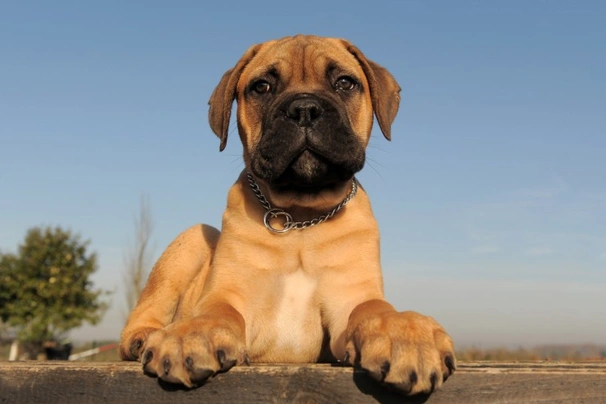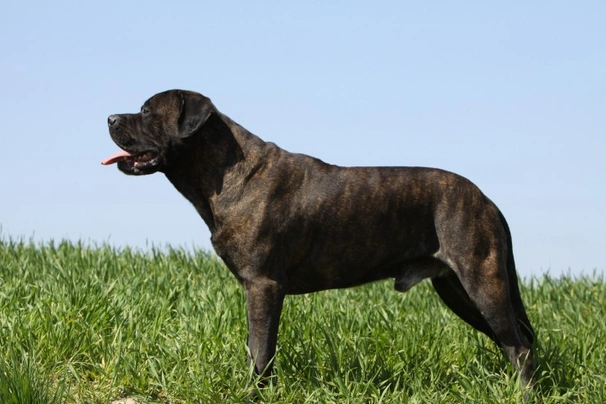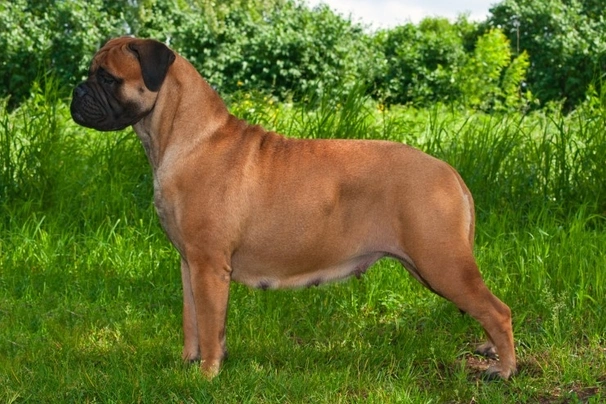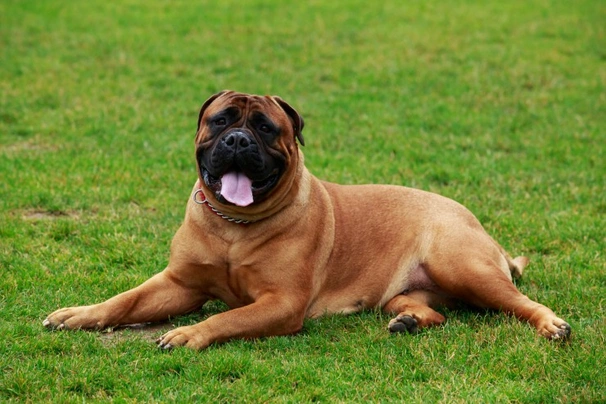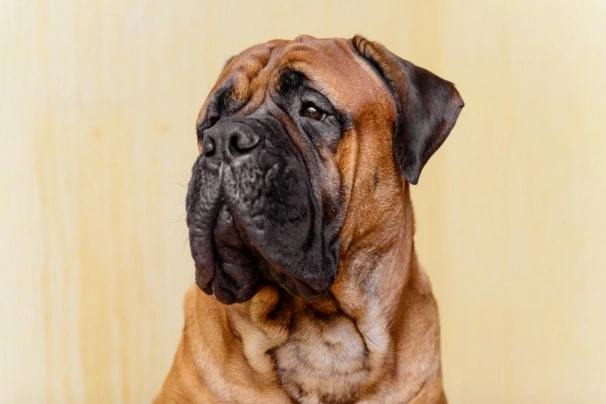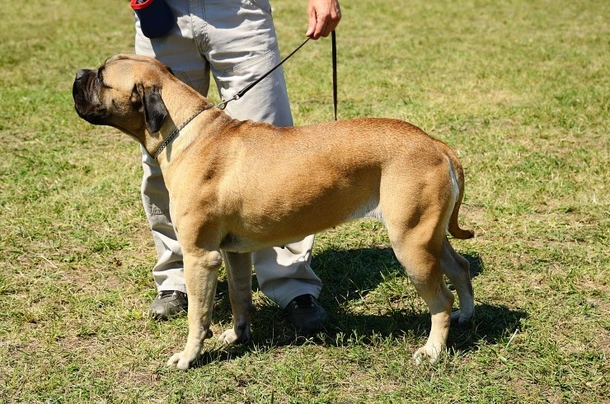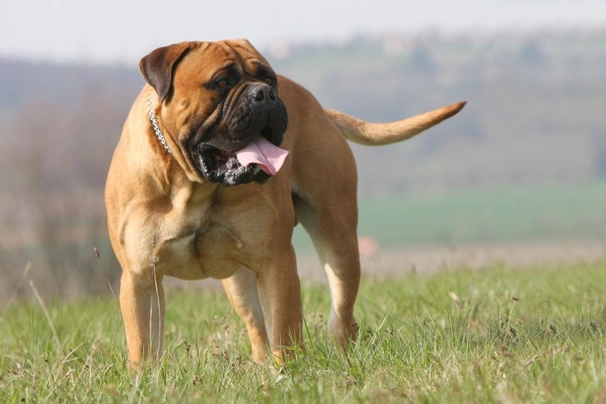Bullmastiff
Pros
Cons
Introduction of the Bullmastiff
Bullmastiffs are powerful looking dogs that are a result of crossing an Old English Mastiff with a Bulldog. Originally bred to help gamekeepers track down poachers these large dogs have become popular companions not only here in the UK but elsewhere in the world too. They are intelligent and alert characters making them easy to train but they do like to know why they are doing anything which is something to bear in mind when training a Bullmastiff. They are known to be high-spirited and quickly become devoted members of a family always ready to protect the people they love and their property.
History of the Bullmastiff
It is thought that dogs of this "type" have been around for hundreds of years both in England and elsewhere in Europe. They were highly prized for their hunting and guarding abilities. The Bullmastiff came about by crossing Mastiff type dogs with Bulldogs but back in the 17th and 18th centuries they did not look like the modern Bullmastiff we see today with dogs looking looked more like a Staffordshire Bull Terrier back then. They were a popular choice with gamekeepers who needed strong powerful looking dogs to help them keep poachers at bay.
It is thought the Bullmastiff has the Molosser and the Alaunt in their lineage and that these two dogs were introduced to Britain around two thousand years ago. The Bullmastiff however was created by crossing them with Old English Bulldogs because gamekeepers in the day wanted a strong robust dog that was capable of not only guarding large flocks of livestock but also of keeping poachers away. Over the years these courageous loyal dogs found their way into other environments which saw them working as sentries guards as well as working alongside the police and the military
However it's also thought that over time other dogs were used to develop the breed which includes Bloodhounds St Bernards and Great Danes. Efforts were made to standardise the breed in the early twentieth century with enthusiasts promoting the breed as much as they could. However the Bullmastiff was only recognised as a breed in 1925. That same year the British Bullmastiff League was formed although at the time it was known as the Midland Bullmastiff Club and the first official breed standard was established.
Although the dogs we see today do not resemble the first Bullmastiffs that were bred back in the day their intelligence their high spirit and the devotion they show towards their owners remains the same which is just one of the reasons why the breed continues to be a popular choice with people the world over.
Interesting facts about the breed
- Is the Bullmastiff a vulnerable breed? No they are among some of the most popular dogs in the UK and elsewhere in the world too
- They are the descendants of the Molloser and the Alaunt which were ancient breeds found in many regions of Europe
- Bullmastiffs were always trained not to bark which is a trait that's deeply embedded in a dog's psyche and therefore they are not “barkers”
- A Bullmastiff starred alongside Sylvester Stallone in the film Rocky and was his own personal pet called Butkus
- Many celebrities have owned and own Bullmastiffs which included Marlon Brandon and the singer Bob Dylan
- A Bullmastiff called Swagger is the NFL mascot
- Bullmastiffs have traditionally had their tails docked a practice that has been going on throughout time. The reason spaniel's tails were docked was to prevent them from being damaged when dogs were flushing out and retrieving game in undergrowth. It was only in 1993 that a law was passed preventing anyone other than a vet from carrying out the procedure but this was further changed when The Animal Health and Welfare Act (Scotland) came into effect in 2006 which invoked a total ban on tail docking unless for medical reasons. In other parts of the UK the Animal Welfare Act came into effect in April 2007 which meant that dog's tails could no longer be docked unless they fell into the category of a specific "working" dog or for medical reasons
Appearance of the Bullmastiff
Height at the withers: Males 64 - 69 cm Females 61 - 66 cm
Average weight: Males 50 - 59 kg Females 41 - 54 kg
Bullmastiffs are muscular powerful and impressive looking dogs that boast devoted natures. They have large square heads and when alert or interested by something wrinkles appear on their faces. They have a very pronounced stop and quite short muzzles with broad noses and wide nostrils. Eyes are either dark or hazel in colour and set wide apart on a dog's head with a very obvious furrow in between them.
Ears are a distinct V shape folded well back and set wide and high on a dog's head. Their ears are small and boast being a slightly deeper colour than the rest of a dog’s body. Their jaw can be very slightly undershot although the more level it is the better. A Bullmastiff boasts strong teeth that are set well apart. Their necks are arched muscular and moderate in length.
Bullmastiffs have wide and deep chests that are well let down in between their front legs which adds to their powerful appearance. They have a deep brisket with muscular sloping and powerful shoulders. Their front legs are straight and very powerful looking set wide apart. Their back is short and level which gives these dogs a very compact look about them.
Hindquarters are muscular with dogs boasting deep flanks and strong muscular back legs. Their feet are very cat-like being well arched and boasting round toes and very hard paw pads with dark coloured nails. A Bullmastiff's tail is set high and is thicker at the base before tapering to the tip which dogs carry straight or slightly curved.
When it comes to their coat the Bullmastiff boasts a short and hard extremely weather-resistant close-lying coat. The accepted breed colours for Kennel Club registration are as follows:
- Brindle
- Brindle With Black Muzzle
- Fawn
- Fawn With Black Muzzle
- Red
- Red With Black Muzzle
Bullmastiffs can have slight white markings on their chests which are acceptable as a breed standard. Their muzzles must be black with the colour blending in with their coats towards their eyes and with dark markings found around their eyes their colouring adds to a Bullmastiff’s expressive face.
Gait/movement
When a Bullmastiff moves they do so with a great sense of purpose and power. Their legs never cross over with their front right and left back leg moving at the same time. Dogs have a firm back with a tremendous amount of thrust coming from their hindquarters showing a lot of balance in a Bullmastiff's gait.
Faults
The Kennel Club frowns on all exaggerations and departures from the breed standard and would judge a fault on how much it affects a dog's overall health and wellbeing as well as their ability to work.
Males should have both testicles fully descended into their scrotums and it is worth noting that a Bullmastiff can be slightly heavier or lighter as well as a little shorter or taller than stated in the Kennel Club breed standard which is given as a guideline only.
Temperament of the Bullmastiff
The Bullmastiff is known to be an extremely loyal and courageous dog that forms a very strong bond with their owners. They need to be well socialised and correctly trained from a young age so they learn their place in the "pack" and who is the alpha dog in a household or they can start to show a more dominant side to their nature. As such these large and powerful dogs need to have an experienced handler who knows how to manage them.
With this said the Bullmastiff is not a good choice for the first-time owner because they might just get the better of them. These dogs are quite high energy and highly intelligent which means they need to be given the right sort of direction from an early age and then throughout their lives for them to be truly well-rounded dogs.
Bullmastiffs tend to be wary around people they don't know and will generally only tolerate being around strangers when they have been introduced to them by their owners. This is just one of the reasons they make such brilliant watch dogs.
Are they a good choice for first time owners?
Bullmastiffs are not the best choice for first time dog owners because they need to be correctly socialised trained and handled by people who are familiar with their specific needs. Mastiffs are strong dogs that need to be taught the ground rules and who is alpha dog in a household or they may take on the role of dominant dog themselves which is something to be avoided at all costs.
What about prey drive?
Bullmastiffs have a strong prey drive and as such care must be taken when walking a dog off the lead in a public place to avoid any incidents and this includes in parks and through the countryside.
What about playfulness?
Bullmastiff puppies like all puppies are very playful bouncy and boisterous which is why they are not that well suited to families with toddlers and very young children. They enjoy playing interactive games with their owners which includes things like "fetch" and catch the ball but thanks to their size and the fact they are a brachycephalic breed care should always be taken not to overdo things which could make it hard for a dog to breath.
What about adaptability?
Bullmastiffs are better suited to people who have secure back gardens rather than apartments because they need to be able to express themselves freely as often as possible which they can safely do in a well-fenced garden.
What about separation anxiety?
Bullmastiffs form strong ties with their families and dogs are never very happy when they find themselves left on their own for longer periods of time. They are better suited to people who either work from home or in households where one person stays at home when everyone else is out so they are never alone for any length of time which could see a dog suffering from separation anxiety. This can lead to them being destructive around the home which is a dog's way of relieving any stress they are feeling and a way to keep themselves entertained.
What about excessive barking?
Bullmastiffs are not known to be "barkers" and will only typically voice an opinion to let an owner know when something they don't like is going on and when strangers are about. It is worth noting that these dogs were always trained not to bark and to go about their jobs of guarding quietly and to catch poachers rather than attack them.
Do Bullmastiffs like water?
Some Bullmastiffs like swimming and will take to the water whenever they can more especially when the weather is hot. However if anyone who owns a dog that does not like water should never force them to go in because it would just end up scaring them. With this said care should always be taken when walking a Mastiff off the lead anywhere near more dangerous watercourses just in case a dog decides to leap in and then needs rescuing. The other thing to bear in mind is that some Mastiffs have trouble breathing because they are a brachycephalic breed which can make swimming more challenging for them.
Are Bullmastiffs good watchdogs?
Bullmastiffs are natural watchdogs and would be quick off the mark to let an owner know when there are strangers about or when something they don't like is going on in their environment. Mastiffs do not need to be trained to guard or protect because these are traits that are deeply embedded in a dog's psyche and as such by doing so it could mean a dog starts to show a more aggressive and dominant side to their nature.
Intelligence / Trainability of the Bullmastiff
Although the Bullmastiff is an intelligent dog they are known to have quite a stubborn streak in them which is why careful yet firm handling is needed right from the word go if you want to share your home with one of them. It's also worth bearing in mind that when they are puppies and adolescents the Bullmastiff can be a little headstrong very lively and boisterous which makes getting them to focus during their training a little more challenging.
Mastiff puppies may be cute but they must be taught the ground rules right from the word go so they understand the limits and boundaries that owners set for them because these cute puppies grow into a powerful strong dogs. The first commands a puppy must be taught include the following:
- Come
- Sit
- Stay
- Quiet
- Leave it
- Down
- Bed
Children and other
Bullmastiffs are not that tolerant of children and as such any interaction between them has to be well supervised by an adult. They are not the best choice for families with very young children or toddlers because an adolescent Bullmastiff tends to be a little too boisterous which could end up with them knocking a young child over and injuring them. They also tend to become extremely protective of their owners and their children which can lead to problems when anyone visits their home.
As such Pets4homes advises that Bullmastiffs are not the best choice for families with babies or very young children. Anyone who already shares a home with a Bullmastiff and who have younger children should always make sure they are never left together unattended. It is also crucial for parents to teach young children how to behave around dogs and when to stay away from them particularly when there is food around or during playtime.
They are generally good around other animals and pets providing they are extremely socialised from a young enough age so they mature into truly well-rounded relaxed characters no matter where they are taken. Care needs to be taken whenever they encounter any dogs and other animals they don’t already know and to carry out the introductions carefully.
Health of the Bullmastiff
The average life expectancy of a Bullmastiff is between 8 and 10 years when properly cared for and fed an appropriate good quality diet to suit their ages.
Like so many other pure breeds they are known to suffer from a few hereditary health issues which are worth knowing about if you are planning share your home with one of these large and lively dogs. The health issues most commonly seen in the breed include the following:
- Brachycephalic Obstructive Airway Syndrome - more especially dogs with very short muzzles
- Cancer
- Hip dysplasia – DNA test available - the breed mean score is 21.7 which is very high as such parent dogs should have a much lower hip score if used for breeding purposes
- Elbow dysplasia - test available
- Persistent pupillary membrane (PPM) - test available and litter screening
- Progressive retinal atrophy (PRA) - annual testing essential for stud dogs
- Progressive Retinal Atrophy (PRA-rho) - DNA test available
- Canine multi-focal retinopathy (CMR) - DNA test available
- Dominant Progressive Retinal Atrophy (PRA-D) - DNA test available
- Bloat/gastric torsion
- Entropion
- Skin Allergies - eczema dermatitis alopecia muzzle pyoderma
- Kidney Stones
- Cervical Malformation
More about head shape in Bullmastiffs
Extreme examples of Bullmastiffs come with many health issues more especially as they are a brachycephalic breed with a wide head and flatter muzzle which means they can have real trouble breathing. A dog's muzzle may be slightly shorter or longer than another dog's muzzle and the shorter it is the more they are at risk of suffering from breathing difficulties which could be very severe leading to a Bullmastiff developing Brachycephalic Obstructive Airway Syndrome.
More about tail docking
Bullmastiffs have traditionally had their tails docked a practice that has been going on throughout time. The reason spaniel's tails were docked was to prevent them from being damaged when dogs were flushing out and retrieving game in undergrowth. It was only in 1993 that a law was passed preventing anyone other than a vet from carrying out the procedure but this was further changed when The Animal Health and Welfare Act (Scotland) came into effect in 2006 which invoked a total ban on tail docking unless for medical reasons. In other parts of the UK the Animal Welfare Act came into effect in April 2007 which meant that dog's tails could no longer be docked unless they fell into the category of a specific "working" dog or for medical reasons.
What about vaccinations?
Bullmastiff puppies would have been given their initial vaccinations before being sold but it is up to their new owners to make sure they have their follow-up shots in a timely manner with the vaccination schedule for puppies being as follows:
- 10 -12 weeks old bearing in mind that a puppy would not have full protection straight away but would be fully protected 2 weeks after they have had their second vaccination
There has been a lot of discussion about the need for dogs to have boosters. As such it's best to talk to a vet before making a final decision on whether a dog should continue to have annual vaccinations which are known as boosters**.**
What about spaying and neutering?
A lot of vets these days recommend waiting until dogs are slightly older before spaying and neutering them which means they are more mature before undergoing the procedures. As such they advise neutering males and spaying females when they are between the ages of 6 to 9 months old. Other vets recommend spaying and neutering dogs when they are 6 months old but never any earlier unless it is for medical reasons.
What about obesity problems?
Some Bullmastiffs gain weight after they have been spayed or neutered and it's important to keep an eye on a dog's waistline just in case they do. If a dog starts to put on weight it's important to adjust their daily calorie intake and to up the amount of exercise they are given. Older Bullmastiffs too are more prone to gaining weight and again it's essential they be fed and exercised accordingly because obesity can shorten a dog's life by several years. The reason being that it puts a lot of extra strain on a dog's internal organs including the heart.
What about allergies?
Bullmastiffs are prone to suffering from allergies and skin issues because of the extra skin that forms folds on their faces which is why it's important for a dog to see a vet sooner rather than later if one flares up bearing in mind that they are prone to suffering from conditions like eczema dermatitis alopecia muzzle pyoderma. Allergies can be notoriously hard to clear up and finding the triggers can be challenging. With this said a vet would be able to make a dog with an allergy more comfortable while they try to find out what the triggers might be for a dog's allergy. The most common triggers include the following:
- Certain foods and more especially commercial pet food that contains high amounts of cereals
- Airborne pollens
- Dust mites
- Environment
- Flea and tick bites
- Chemicals found in everyday household cleaning products
Participating in health schemes
All responsible Bullmastiff breeders would ensure that their stud dogs are tested for known hereditary and congenital health issues known to affect the breed by using the following scheme:
- BVA/KC Hip Dysplasia Scheme
- Elbow dysplasia
- Persistent pupillary membrane (PPM)
- Progressive retinal atrophy (PRA) - annual testing
- Progressive Retinal Atrophy (PRA-rho) - DNA test available
- Canine multi-focal retinopathy (CMR) - DNA test available
- Dominant Progressive Retinal Atrophy (PRA-D) - DNA test available
What about breed specific breeding restrictions?
Apart from the standard breeding restrictions for all Kennel Club registered breeds there are no other breed specific breeding restrictions for the Bullmastiff.
What about Assured Breeder Requirements?
The Kennel Club strongly advises that all breeders including all Assured Breeders use the following test on their stud dogs:
Caring for the Bullmastiff
As with any other breed Bullmastiffs need to be groomed on a regular basis to make sure their coats and skin are kept in top condition bearing in mind that the breed is known to be prone to skin issues and allergies thanks to the folds and creases around a dog’s face. They also need to be given regular daily exercise to ensure they remain fit and healthy. On top of this they need to be fed good quality food that meets all their nutritional needs throughout their lives.
Caring for a Bullmastiff puppy
Bullmastiff puppies are boisterous and full of life which means it's essential for homes and gardens to be puppy-proofed well in advance of their arrival. A responsible breeder would have well socialised their puppies which always leads to more outgoing confident and friendly dogs right from the word go. With this said any puppy is going to feel vulnerable when they leave their mother and littermates which must be taken into account. The longer a puppy can remain with their mother the better although it should never be for too long either.
It's best to arrange to pick puppy up when people in the home are going to be around for the first week or so which is the time needed for a puppy to settle in. Puppy-proofing the home and garden means putting away any tools and other implements that a boisterous puppy might injure themselves on. Electric wires and cables must be put out of their reach because puppies love chewing on things. Toxic plants should be removed from flowerbeds and the home too.
Puppies need to sleep a lot to grow and develop as they should which means setting up a quiet area that's not too out of the way means they can retreat to it when they want to nap and it's important not to disturb them when they are sleeping. It's also a good idea to keep "playtime" nice and calm inside the house and to have a more active "playtime" outside in the garden which means puppies quickly learn to be less boisterous when they are inside.
The documentation a breeder provides for a puppy must have all the details of their worming date and the product used as well as the information relating to their microchip. It is essential for puppies to be wormed again keeping to a schedule which is as follows:
- Puppies should be wormed at 6 months old
- They need to be wormed again when they are 8 months old
- Puppies should be wormed when they are 10 months old
- They need to be wormed when they are 12 months old
Things you'll need for your puppy
There are certain items that new owners need to already have in the home prior to bringing a new puppy home. It's often a good idea to restrict how much space a puppy plays in more especially when you can't keep an eye on what they get up to bearing in mind that puppies are often quite boisterous which means investing in puppy gates or a large enough playpen that allows a Bullmastiff puppy the room to express themselves while keeping them safe too. The items needed are therefore as follows:
- Good quality puppy or baby gates to fit on doors
- A good well-made playpen that's large enough for a puppy to play in so they can really express themselves as puppies like to do
- Lots of well-made toys which must include good quality chews suitable for puppies to gnaw on bearing in mind that a puppy will start teething anything from when they are 3 to 8 months old
- Good quality feed and water bowls which ideally should be ceramic rather than plastic or metal
- A grooming glove
- A slicker brush or soft bristle brush
- Dog specific toothpaste and a toothbrush
- Scissors with rounded ends
- Nail clippers
- Puppy shampoo and conditioner which must be specifically formulated for use on dogs
- A well-made dog collar or harness
- A couple of strong dog leads
- A well-made dog bed that's not too small or too big
- A well-made dog crate for use in the car and in the home that's large enough for a puppy to move around in
- Baby blankets to put in your puppy's crate and in their beds for when they want to nap or go to sleep at night
Keeping the noise down
All puppies are sensitive to noise including Bullmastiff puppies. It's important to keep the noise levels down when a new puppy arrives in the home. TVs and music should not be played too loud which could end up stressing a small puppy out.
Keeping vet appointments
As previously mentioned Bullmastiff puppies would have been given their first vaccinations by the breeders but they must have their follow up shots which is up to their new owners to organise. The vaccination schedule for puppies is as follows:
- 10 -12 weeks old bearing in mind that a puppy would not have full protection straight away but would only be fully protected 2 weeks after they have had their second vaccination
When it comes to boosters it's best to discuss these with a vet because there is a lot of debate about whether a dog really needs them after a certain time. However if a dog ever needed to go into kennels their vaccinations would need to be
What about older Bullmastiff when they reach their senior years?
Older Bullmastiffs need lots of special care because as they reach their golden years they are more at risk of developing certain health concerns. Physically a Bullmastiff will start to have a greying muzzle but there will be other noticeable changes too which includes the following:
- Coats become coarser
- A loss of muscle tone
- Bullmastiffs can either become overweight or underweight
- They have reduced strength and stamina
- Older dogs have difficulty regulating their body temperature
- They often develop arthritis
- Immune systems do not work as efficiently as they once did which means dogs are more susceptible to infections
- Older dogs change mentally too which means their response time tends to be slower as such they develop the following:
- They respond less to external stimuli due to impaired vision or hearing
- They tend to be a little pickier about their food
- They have a lower pain threshold
- Become intolerant of any change
- Often an older dog can feel disorientated
Living with a Bullmastiff in their golden years means taking on a few more responsibilities but these are easily managed and should include taking a look at their diet the amount of exercise they are given how often their dog beds need changing and keeping an eye on the condition of their teeth.
Older Bullmastiffs need to be fed a good quality diet that meets their needs at this stage of their lives all the while keeping a close eye on a dog's weight. A rough feeding guide for older Bullmastiffs is as follows bearing in mind they should be fed highly digestible food that does not contain any additives:
- Protein content should be anything from 14 – 21%
- Fat content should be less than 10%
- Fibre content should be less than 4%
- Calcium content should be 0.5 – 0.8%
- Phosphorous content should be 0.4 – 0.7%
- Sodium content should be 0.2 – 0.4%
Older Bullmastiffs don't need to be given the same amount of daily exercise as a younger dog but they still need the right amount of physical activity to maintain muscle tone and to prevent a dog from putting on too much weight. All dogs need access to fresh clean water and this is especially true of older dogs when they reach their golden years because they are more at risk of developing kidney disorders.
Grooming of the Bullmastiff
Bullmastiffs are relatively easy maintenance in the grooming department all thanks to their short tight coat. This means a weekly session using a grooming mitt will keep any dead hair off the furniture and their coats looking good and gleaming. It's also a good idea to keep an eye on a dog's ears and to clean them when necessary to prevent any build-up of wax which could result in an ear infection taking hold. This type of ear infection can be notoriously hard to clear up.
However because Bullmastiffs are so prone to develop skin issues on their faces and muzzles thanks to the folds it is essential for the creases to be regularly cleaned to prevent a flare up. The folds provide the perfect environment for bacteria because they are warm and moist which is everything that bacteria can thrive in.
Exercise of the Bullmastiff
A Bullmastiff needs to be given at least an hour to two hour's exercise a day. However any dogs under a year old should not be taken on very long walks because their joints and bones are still developing. Putting too much strain on them could result in dogs developing joint issues later on in their lives.
Being intelligent dogs the Bullmastiff really likes to be given a lot of mental stimulation to be truly happy well-rounded dogs and this includes playing lots of interactive games with their owners and families. They also benefit from being allowed to roam around a back garden as often as possible providing the fencing is very secure.
Feeding of the Bullmastiff
If you get a Bullmastiff puppy from a breeder they would give you a feeding schedule and it's important to stick to the same routine feeding the same puppy food to avoid any tummy upsets. You can change a puppy's diet but this needs to be done very gradually always making sure they don't develop any digestive problems and if they do it's best to put them back on their original diet and to discuss things with the vet before attempting to change it again.
Feeding a Bullmastiff can prove a bit challenging because they are known to be a little demanding. This means setting up a feeding program and to stick to it to prevent any upsets. It's best to feed a mature Bullmastiff twice a day once in the morning and then again in the evening making sure it's good quality food that meets all their nutritional requirements. It's also important not to feed a dog just before they go out for a walk or when they just get back from one. The reason being that Bullmastiffs are prone to suffering from bloat (gastric torsion) and if they eat when they are still hot or just before they go out for any exercise it increases the chance of them suffering from this painful and serious disorder.
It's also important that dogs be given the right amount of exercise so they burn off any excess calories or they might gain too much weight which can lead to all sorts of health issues. Obesity can shorten a dog's life by several years so it's important to keep an eye on their waistline from the word go.
Feeding guide for a Bullmastiff puppy
Puppies need to be fed a highly nutritious good quality diet for them to develop and grow as they should. As a rough guide a Bullmastiff puppy can be fed the following amounts every day making sure their meals are evenly spread out throughout the day and it's best to feed them 3 or 4 times a day:
- 2 months old - 309g to 394g depending on puppy's build
- 3 months old - 406g to 504g depending on puppy's build
- 4 months old - 449g to 556g depending on puppy's build
- 5 months old - 534g to 658g depending on puppy's build
- 6 months old - 607g to 749g depending on puppy's build
- 7 months old - 609g to 756g depending on puppy's build
- 8 months old - 605g to 755g depending on puppy's build
- 9 months old - 557g to 745g depending on puppy's build
- 10 months old - 521g to 658g depending on puppy's build
- 11 months old - 476g to 613g depending on puppy's build
- 12 months old - 434g to 574g depending on puppy's build
- 13 months old - 431g to 535g depending on puppy's build
- 14 months old - 557g to 745g depending on puppy's build
Once a Bullmastiff is 18 months old they can be fed adult dog food.
Feeding guide for an adult Bullmastiff
Once fully mature an adult Bullmastiff must be fed a good quality diet to ensure their continued good health. As a rough guide an adult Bullmastiff can be fed the following amounts every day:
- Dogs weighing 41 kg can be fed 394g to 519g depending on activity
- Dogs weighing 50 kg can be fed 449g to 578g depending on activity
- Dogs weighing 54 kg can be fed 458g to 603g depending on activity
- Dogs weighing 59 kg can be fed 469g to 628g depending on activity
Bullmastiff price
If you are looking to buy a Bullmastiff you would need to pay anything from £800 to over £1000 for a well-bred pedigree puppy. The cost of insuring a male 3-year-old Bullmastiff in northern England would be £61.22 a month for basic cover but for a lifetime policy this would set you back £115.19 a month (quote as of October2017). When insurance companies calculate a pet's premium they factor in several things which includes where you live in the UK and a dog's age and whether they have been neutered or spayed.
When it comes to food costs you need to buy the best quality food whether wet or dry to feed your dog throughout their lives making sure it suits the different stages of their lives. This would set you back between £50 - £80 a month. On top of this you would need to factor in veterinary costs if you want to share your home with a Bullmastiff and this includes their initial vaccinations their annual boosters the cost of neutering or spaying your dog when the time is right and their yearly health checks all of which quickly adds up to over a £1400 a year.
As a rough guide the average cost to keep and care for a Bullmastiff would be between £120 to £200 a month depending on the level of insurance cover you opt to buy for your dog but this does not include the initial cost of buying a well-bred healthy Kennel Club registered pedigree Bullmastiff puppy.
Buying advice
When visiting and buying any puppy or dog there are many important things to consider and questions to ask of the breeder/seller. You can read our generic puppy/dog advice here which includes making sure you see the puppy with its mother and to verify that the dog has been wormed and microchipped.
Bullmastiffs are an extremely popular breed both in the UK and elsewhere in the world which means that well-bred puppies command a lot of money. As such with Bullmastiffs there is specific advice questions and protocols to follow when buying a puppy which are as follows:
- Beware of online scams and how to avoid them. You may see online and other adverts by scammers showing images of beautiful Bullmastiff puppies for sale at very low prices. However the sellers ask buyers for money up front before agreeing to deliver a puppy to a new home. Potential buyers should never buy a puppy unseen and should never pay a deposit or any other money online to a seller. You should always visit the pet at the sellers home to confirm they are genuine and make a note of their address.
- As previously touched upon Bullmastiff are among the most popular breeds in the UK. As such there are many amateur breeders/people who breed from Mastiff far too often so they can make a quick profit without caring for the welfare of the puppies their dam or the breed in general. Under Kennel Club rules a dam can only produce 4 litters and she must be between a certain age to do so. Anyone wishing to buy a Bullmastiff puppy should think very carefully about who they purchase their puppy from and should always ask to see the relevant paperwork pertaining to a puppy's lineage their vaccinations and their microchipping
- Bullmastiffs have traditionally had their tails docked a practice that has been going on throughout time. The reason spaniel's tails were docked was to prevent them from being damaged when dogs were flushing out and retrieving game in undergrowth. It was only in 1993 that a law was passed preventing anyone other than a vet from carrying out the procedure but this was further changed when The Animal Health and Welfare Act (Scotland) came into effect in 2006 which invoked a total ban on tail docking unless for medical reasons. In other parts of the UK the Animal Welfare Act came into effect in April 2007 which meant that dog's tails could no longer be docked unless they fell into the category of a specific "working" dog or for medical reasons

Luna
£100
🐾 KC Registered Bullmastiff Puppies! 🐾
£2,000
